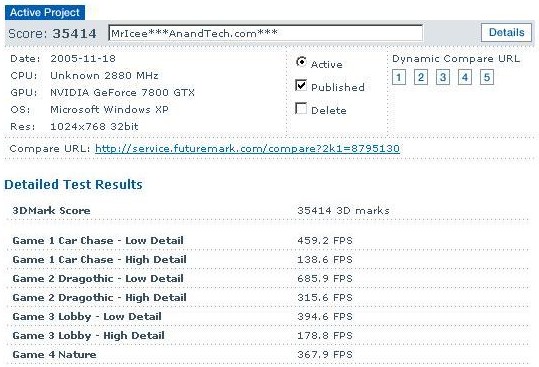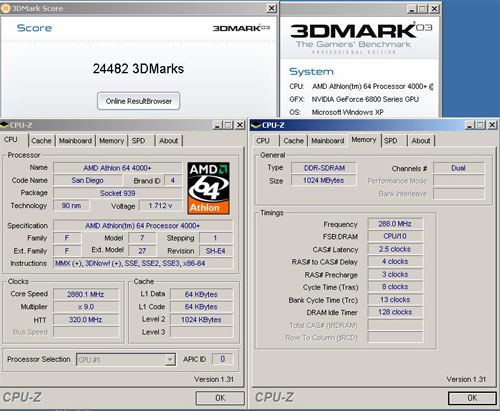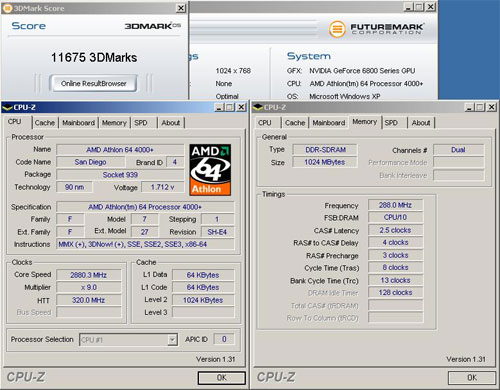DFI NF4 SLI-DR Expert – Can the best get better?
by Randi Sica on November 25, 2005 12:05 PM EST- Posted in
- Motherboards
DFI NFR SLI-DR Expert – Overclocked 3D benchmark performance + SLI verification
3DMark 2001 and Aquamark3
3DMark 2003
3DMark 2005
Our SLI verification tests again utilized the 4000+ San Diego. Comparison tests were done to determine what combination of memory and divider would consistently produce the highest scores. The highest stable and benchmark repeatable CPU speed was 2880Mhz. BH-5 modules at the 166 divider (261 MHz) were evaluated against TCCD modules at the 180 divider (288Mhz), and scores were consistently higher with the TCCD. 2x512MB Corsair 3200XL modules (2.96V) that were used along with a pair of NVIDIA 6800 Ultra’s.
3DMark 2001 and Aquamark3

3DMark 2003
3DMark 2005
Our SLI verification tests again utilized the 4000+ San Diego. Comparison tests were done to determine what combination of memory and divider would consistently produce the highest scores. The highest stable and benchmark repeatable CPU speed was 2880Mhz. BH-5 modules at the 166 divider (261 MHz) were evaluated against TCCD modules at the 180 divider (288Mhz), and scores were consistently higher with the TCCD. 2x512MB Corsair 3200XL modules (2.96V) that were used along with a pair of NVIDIA 6800 Ultra’s.













40 Comments
View All Comments
karioskasra - Saturday, November 26, 2005 - link
Agreed. The nb fan on the dfi sounds like a cat getting mauled. It's enough to make you go water just for the quiet.karioskasra - Saturday, November 26, 2005 - link
I'm calling for dual cores to be included in the standard test setup.Bozo Galora - Saturday, November 26, 2005 - link
newegg has them in stock - 2 billsdecptt - Friday, November 25, 2005 - link
I wanna ask the author.Have you tested 4x1GB yet?
Can it see 4GB or can't it?
What timing do you use?
RSica - Saturday, November 26, 2005 - link
I did not test with 4x 1GB sticks because I only have 2 in my possession for reviewing. I did in fact as mentioned run 4x512MB sticks at 2T with no problem whatsover for testing.Future reviews will very well see x2 A64's included but I'm not sure what the timetable will be for their inclusion.
Again, thank you for your comments !
Randi
cryptonomicon - Saturday, November 26, 2005 - link
i think the article said that it couldn't pass 1T for 4x1gb, but it can run it (at 2t).SignalPST - Friday, November 25, 2005 - link
Thanks Randi for the very detailed review of the Expert.I was wondering, with the new layout of the RAM slots and CPU, is it possible to populate all 4 RAM slots and still be able to fit the thermalright XP-120 without problems?
tjr508 - Friday, November 25, 2005 - link
Bravo to DFI for using decent power supplies and such, but why is the SIL 3114 such a dissapointment? Does any desktop user need SATA2 at this time? Does anyone need DDR2 as opposed to high quality DDR (not this board but in a couple months). This whole idea of "futureproofing" drives me crazy. It may be nice if people saw mobos they liked and baught them to keep them in a closet for a couple years, but I believe most people buy their systems within a week or so. I can understand buying a 3000+ and maybe sticking in a $30 fx57 in three or four years, but you can do that with any board on the market pretty much. Adopting future standards before they can provide reasonable performance improvements will alter your financial experience far more than your computing experience. Then again I would have to blame the consumers more so than the companies as their tactics are obviously making them money. I would love to know how many SLI boards out there have one video card attached to them as well as how many unsued SATA channels there are out there. I just think it is dissapointing that in today's market its hard to find an extra feature you want without paying for five more that you don't.Tanclearas - Friday, November 25, 2005 - link
I had to double-check that I was indeed still reading a review at Anandtech.Since when is the max FSB of a motherboard determined using any memory ratio other than 1:1?
How many other boards reviewed at AT were booted into Windows at a certain FSB before being cranked up?
Why the change in CPU from previous tests (using a 3500 rather than 4000)?
What is with the graph for Futuremark that compares the different component scores of the same board? What is the point of graphing those numbers?
Where is the comparison to the A8N32-SLI? I'm pretty sure that's the benchmark board right now for enthusiasts.
I didn't even finish reading the review.
RSica - Friday, November 25, 2005 - link
Good Morning :)_The object of the testing was to not only find the max 1:1 clockability of the board (310Mhz), but to find it's ability to reach the HTT limits of 2 different CPU's in our possession which certainly necessitates using a divider.
-This board booted into Windows at 510Mhz HTT. Having come from an extensive overclocking background, it is recognized that the fact a board will not boot into Windows at a specified speed does not necessarily mean the board/CPU will not function at an increased HTT speed. In this case, to determine the maximum HTT the Expert and 3500+ Winchester could attain the use of the Popular overclocking program ClockGen, and it only resulted in an additional 2Mhz HTT.
There are many readers that indeed take great interest in the overall top HTT overclockability of a board.
- The change in CPU's was merely to find the boards ability to overclock the HTT to it's maximum. This gem of a 3500+ was known to have reached an HTT of 500Mhz previously. The 4000+ has a maximum HTT of 400Mhz. Of course for all tests other than the Extreme Overclocking section, the 4000+ was utilized fror straight up comparisons.
-I have updated the gaming performance graphs which includes comparison to the A8N32-SLI
I'll update the other graphs as time allows.
I thank you wholeheartedly for your comments, Randi :)